| Picture |
Information |
|

|
Sardine (Sardina pilchardus) -
Silver in colour with a blue back.
Habitat -
They form schools, usually at depths of 25 to 55 or even 100 m by day, rising to 10 to 35 m at night.
Diet -
Feed mainly on planktonic crustaceans, also on larger organisms.
|
|

|
Scad or Atlantic Horse Mackerel (Trachurus trachurus) -
Bluish green, grey or black above, silvery white below; opercle with black spot. Lateral scales tall and keeled. Gill cover with a distinct black spot. First dorsal fin tall.
Habitat -
Adults form large schools in coastal areas with sandy substrate. Scad can be caught very close to the shoreline useing a float rig.
Diet -
They feed on fish, crustaceans, and cephalopods. Strips of fish etc, or they can also be captured on feathers not unlike Mackerel.
|
|
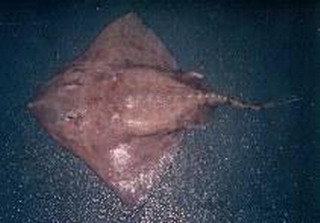
|
Skate (Dipturus batis) -
Skate and Ray has a distinctive diamond-shaped body. The upper surface is olive grey or brown with a variable pattern of light spots, and the underside is ashy grey to blue grey.
Habitat -
Found in coastal waters mainly within the 100m - 200m range.
Diet -
They feed on all kinds of bottom animals, large individuals prefer fish.
|
|
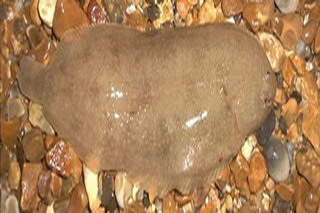
|
Common Sole (Solea solea) -
Body oval, head rounded. Upper eye less than its own diameter from dorsal profile of head. Anterior nostril on blind side not enlarged. Dorsal fin beginning on upper profile of head. Eye side grayish-brown to reddish brown, with large and diffuse dark spots. Pectoral fin on eye side with a blackish blotch at posterior end of fin. Hind part of caudal fin generally darker than rest.
Habitat -
The Sole is a nocturnal flatfish that can be caught close to the shore from sandy beaches as the name suggests it is sole shape in appearance with a hooked shape mouth.
Diet -
Usually solitary. They burrow into sandy and muddy bottoms. Retreat to deeper water during winter. They feed on worms, mollusks and small crustaceans at night.
ragworm and lugworm, lugworm left to go stale is a common favourite.
|
|
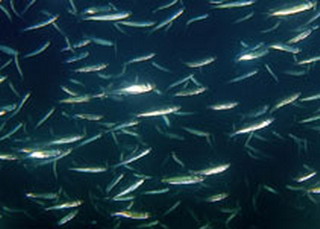
|
European Sprat (Sprattus sprattus) -
Silver in colour with a blue back.
Habitat -
Usually inshore schooling, sometimes entering estuaries (especially the juveniles).Their usual depth range is 10m - 150m.
Diet -
Feeds on planktonic crustaceans.
|
|
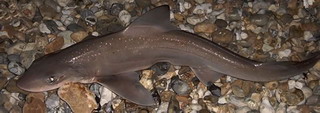
|
Starry Smooth Hound (Mustelus asterias) -
It is distinguishable from the Common Smooth hound as it is covered by lots of small white spots.
Habitat -
A common inshore and offshore shark found on the continental and insular shelves from the intertidal down to at least 100m. It prefers sandy and gravelly bottoms. Thet feed primarily on crustaceans (crabs, hermit crabs, lobsters and slipper lobsters).
Diet -
Peeler Crab or Hermit Crab are the best baits for Starry Smoothhounds.
|
|
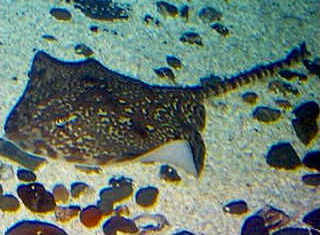
|
Thornback Ray (Raja clavata) -
Upper surfaces wholly prickly, underside wholly prickly in large females, only snout and margins of disc in young and large males; orbital thorns separate, 30-50 in median row from nape to first dorsal fin; additional large 'buckler' thorns with swollen bases scattered on upper surface of disc in adults. Sub rhomboid disc, disc-width 1,25 to 1,36 times in its length, its length 1,70 to 1,83 times in total length; short rostrum, rounded at his extremity; pectoral fins with clear angles on lateral side; triangular pelvic fins. Upper surface very variable, all shades of brown, variegated with dark and light spots and blotches, underside white
Habitat -
Inhabits the shelf and upper slope waters from the coastal line to about 300m. Depth range from 20m - 300m. Found on sand and sand rock bottoms.
Diet -
It feeds on all kinds of bottom animals, preferably crustaceans.
|
|
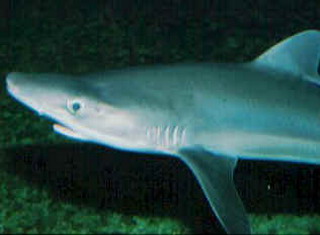
|
Tope Shark (Galeorhinus galeus) -
A large houndshark with a long, pointed snout, a large mouth, and small blade like teeth; 2nd dorsal about as large as anal fin and terminal caudal lobe as long as rest of fin. Greyish above, white below; young with black markings on fins.
Habitat -
Found on continental and insular shelves, but also on the upper slopes, at depths from near shore to 550m.
Diet -
Feeds on fish, crustaceans, cephalopods, worms, and echinoderms.
|
|
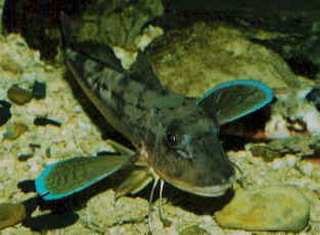
|
Tub Gurnard (Chelidonichthys lucerna) -
Longest ray in the pectoral fin reaching the front part of the anal fin. Lateral line scales smooth. Reddish color. It has three isolated rays on the pectoral fin which function as legs on which the fish rests and also help in locating food on the soft bottom
Habitat -
Inhabits sand, muddy sand or gravel bottoms. Up to depth of 318m.
Diet -
It feeds on fish, crustaceans and mollusks.
|
|
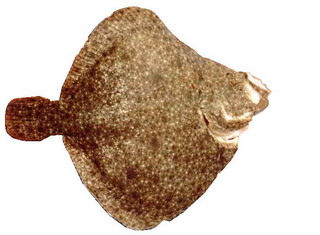
|
Turbot (Psetta maxima) -
Body almost circular with eyes on the side, also without scales but with large bony tubercles.
Habitat -
Turbot generally inhabit waters of 20m - 80m, Adults live on sandy, rocky or mixed bottoms; rather common in brackish waters.
Diet -
Food consists mainly of small fish, such as sandeels, gobies and sprats, but turbot may also take crustaceans and molluscs.
|
|

